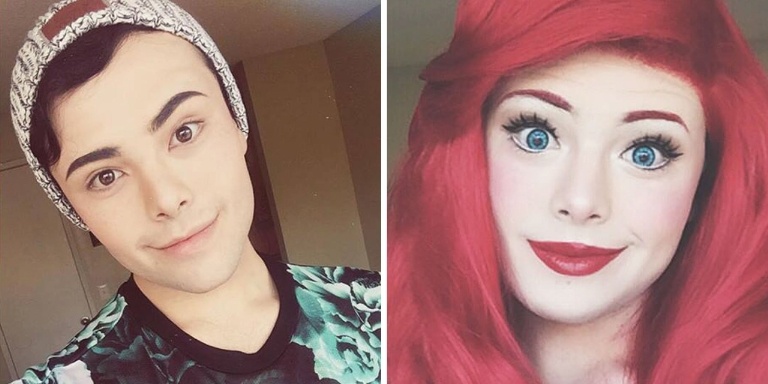Dina’s Diner 9/26/16
IMAGINE A WORLD WITHOUT. . . MAKEUP
The New York Times Thursday Styles section had an article about the nascent “no makeup” movement in its September 15, 2016 edition. The musician Alicia Keys is the most famous of the evangelists for this new way of being (and seeing) women.
The Times article was rather long and got into much discussion about whether makeup is empowering; no makeup is empowering; the genesis of makeup that doesn’t look like makeup; criticism of women like Ms. Keys who “go natural”; women who stop coloring their hair to hide the gray; and why dressing fashionably is seen as okay by some while using cosmetics to enhance the face is looked down on by some of the same people. It covered a lot of ground.
Although some feel that cosmetics are now a tool of suppression to make women meet a mostly male created beauty standard, using cosmetics can also make some women feel more positive about their appearance and themselves, giving them a feeling of empowerment. Oh, yeah, it’s complicated and there is no eyebrow pencil line delineating where suppression starts and self-confidence ends.
Alicia Keys told the Times that it was hard to cut the makeup habit because as a celebrity you are afraid of being photographed at less than your best. But she managed to get past her own insecurities to boldly go where few women have gone before: without cosmetics on national television. As the Times reports, she was roundly criticized and second-guessed for her choice by other women. Keys’ husband went online to scold her detractors negativity. “This is deep. Someone’s sitting home mad because someone else didn’t wear makeup on her face?” he asked sarcastically.
The Times recounts several instances where women attacked other women for not meeting beauty expectations. Journalist Anne Kreamer, who stopped coloring her hair and went gray almost ten years ago said she was criticized by other women at the time “as if doing without [color] herself, she was taking something away from them.” A co-founder of the women’s empowerment magazine Ms wrote of her mixed feelings about a colleague’s chin augmentation surgery. She eventually came to realize, “If a feature distracts people from what they feel is their true selves, who can argue with their alteration of that feature?” That is what self empowerment is all about — even if it involves cosmetics or cosmetic surgery.
I think it’s safe to say that crossdressers would be in a tough place without cosmetics. The natural look just doesn’t work for most M-t-F transgenders but especially crossdressers who aim for the popular image of glamour and all that entails. To come to some form of mastery of cosmetic application is one of the first steps towards being our femme selves. For us, makeup is empowering. It allows us to be who we wish to be — even if just for a short time.
OPEN YOUR LESSON BOOK TO PAGES 36-24-36
Some internet sites were abuzz about Atlanta, Georgia school teacher Patrice Brown’s classroom fashions. Most of the articles seemed to publish on and after September 12, 2016. Ms. Brown posted some photos of herself in the classroom and ignited a controversy over whether her fashion choices were appropriate for an elementary classroom.
Apparently, the photos were posted by Ms. Brown on her own Instagram account (now filtered to private). According to a reporter for Essence magazine who weighed in defending the teacher, the photos were not even recent and not necessarily reflective of all her postings. The rest of the controversy broke down between those scolding her for being inappropriately dressed, those who were incensed that her critics were “body shaming” her zaftig curves, and guys who inevitably hyperventilated over Patrice’s racked and stacked body. Some commenters also raised the question of whether Ms. Brown, who is African-American, was being singled out because of her race. She was dubbed #TeacherBae on Twitter which I had to look up to find out that “Bae” is a newfangled term of endearment.
One defender of Ms. Brown wrote that the criticism was unwarranted because she was “covered” in all the photos. Well, yeah. A leather or latex catsuit would “cover” someone too. That doesn’t make it a good fashion choice for a grade school classroom. The aforementioned writer for Essence complained that Ms. Brown was being exploited by others who shared her photos (to garner attention for themselves) only to criticize her dress as “inappropriate.” She also criticized the Atlanta school district who issued a public press release to inform the world that they had “spoken to” Patrice about her dress choices. There are not many people being covered in glory in this development.
At the risk of sounding like a typical male, the term “inappropriate dress” is almost an oxymoron when applied to women. The more “inappropriate” the better, most of us would say. But let’s face it, there’s a time and a place for everything. When I was involved with a crossdressing support group in the ’90s, we had criticisms that some members came to meetings dressed inappropriately in micro minis, PVC, fishnet stockings, etc. Somehow, the group survived. One comment pointed out that nobody re-posted the photo of teacher Patrice Brown sitting one-on-one with a student reviewing a lesson in a textbook. That photo of a concerned and caring teacher with one of her students was also on Patrice’s Instagram page.
HE’S JUST A PRINCE — OR PRINCESS — OF A GUY
Many news and entertainment websites had articles about Richard Schaefer, a renowned cosplayer, this summer. The PopSugar.com site had it on September 5, 2016, other sites picked it up even earlier.
Mr. Schaefer is only 21 years old and began cosplaying as his favorite Disney characters (mostly female characters) when he was still in his teens. According to the articles, Schaefer is a fashion design student and free lance makeup artist from Southern California. It’s amazing not only that he has so perfected the makeup artistry, wigging and costuming but that he did so at such a young age. Aside from admiring his results, he deserves great respect for his single-minded focus on this creative expression. He has an Instagram photo account under the name “The Official Ariel.”
The U.K.’s Daily Mail website reported that Richard has 40 costumes and 30 wigs that allow him to portray Ariel the Little Mermaid, Queen Elsa, Snow White, Rapunzel and others. He also does some male characters like Peter Pan and Aladdin. “I decided to start cosplaying as princesses because of how androgynous people used to say I was. Curiosity got the best of me, so I decided to transform myself into my favorite princess — Ariel, who I have loved since I was a child. I was pleasantly surprised at how convincing I looked so I decided to stick at it and try different princesses too” he told a reporter. He also said, “I often receive rude comments but I’m quick to shut them down by turning their comment into a joke. I’m sure of myself and who I am, so I never take someone else’s opinion to heart.”
He wows spectators and other participants at cosplay events and special days at Disneyland when amateurs are allowed to dress up as characters in the park. He must be using special contact lenses because he has the large anime-style eyes that cannot be natural. But as you can see, the total effect is pretty stunning. I couldn’t find any other non-cosplay crossdressing photos of Mr. Schaefer so perhaps his hobby is confined to fairy tale impersonations. Just as well. Imagine going up against him in a Halloween drag costume contest.
ISN’T THAT JOE’S TATTOO AND NIRVANA POSTER?
I spend a lot of time looking at photos of crossdressers on sites like Flickr.com and Tumblr.com. I’m always interested in seeing someone who has some unique personal style or makeup talent or fetish-y interest to share with the world. Most of us who have posted photos online feel pretty secure that our identities are safely masked by cosmetics and wigs so that family, friends or co-workers wouldn’t recognize us if they stumbled onto our online photo caches. Certainly there are some crossdressers who aren’t concerned at all about being discovered.
I often wonder about this when I see a crossdresser with a visible, distinctive tattoo. Aren’t they concerned about outing themselves should someone recognize it? Similar questions arise when I see someone photographing themselves in their home or apartment with singular furnishings or decorations in the background. If confronted, one could always ask why the other person was looking at crossdresser photo albums online in the first place. (Ah-ha!) But, of course, that retort can only be applied after the cat(woman) is out of the bag, so to speak.
Back in the pre-internet days, I corresponded with a crossdresser in California who would send photos with her letters. One or two photos had what appeared to be an Oscar statuette on a bookshelf behind her. Maybe it was a reproduction . . . or maybe it was real. Her secret — if it was that — was safe with clueless me but someone else might have been able to put two and two together and get four.
I had my own miscue on photographing myself many years ago in a sporting motif with a basketball. Only after I got the photos back from the developer did I notice that the ball had my last name written in Magic-Marker on the grain facing the camera. So those pix were kept safely tucked away and are still somewhere in the dusty archives. Not so shy are those few crossdressers who post “before and after” photos. These are sometimes interesting to evaluate the subject’s cosmetic transformation but for me it falls into the “too much information” category. I prefer the illusion — like a good magic trick — to be left a mystery, thank you very much.
Category: Transgender Fun & Entertainment, Transgender Opinion







